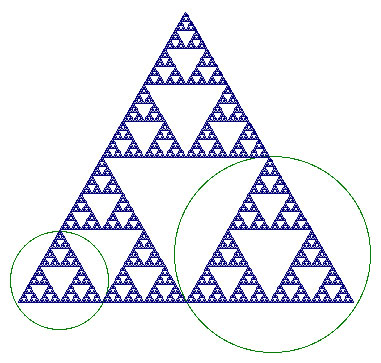1. This fractal rule for the fractal Cantor dust is: take
out the middle third or each segment in the previous iteration.
A. Draw the next iteration of the fractal
| iteration 0 |
 |
| iteration 1 |
 |
| iteration 2 |
 |
| new: iteration 3 |
 |
B. Complete the table below, and explain your rule for finding the numbers
that go in the table
| iteration number |
number of pieces |
length of each piece |
total length |
| 0 |
1 |
1 |
1 |
| 1 |
2 |
1/3 |
2/3 |
| 2 |
4 |
1/9 |
4/9 |
| 3 |
8 |
1/27 |
8/27 |
| n |
this doubles each time because a single segment is traded for two smaller
segments.
2n OR beacause each new iteration is made of two smaller copies of the previous iteration |
the denominator is multiplied by 3 each time OR the length is multiplied
by 1/3 each time OR the length is divided by 3 each time because when you remove the middle third, the segments
left are each 1/3 as long as the previous segment
1/3n |
previous # * 2/3 or
2n/3n |
2. The fractal rule for the Koch curve is to replace each
segment with a new shape (shown below) which is formed by erasing the middle
third, and putting in two segments that would make an equilateral triangle
in its place:
Segment was: |
Changed to: |
 |
 |
A. Draw the next iteration:
| iteration 0 |
 |
| iteration 1 |
 |
| iteration 2 |
 |
| new: iteration 3 |
 |
B. Complete the table below, and explain your rule for finding the numbers
that go in the table
| iteration number |
number of pieces |
length of each piece |
total length |
| 0 |
1 |
1 m |
1 m |
| 1 |
4 |
1/3 m |
4/3 m |
| 2 |
16 |
1/9 m |
16/9 m |
| 3 |
64 |
1/27 m |
64/27 m |
| |
multiply by 4 because each segment is replaced by 4 smaller segments*
4n |
divide by 3 (or x 1/3) because when you remove a middle third the remaining
segments are 1/3 as long as the previous one**
3n |
2n/3n |
* Each segment replaced by 4 smaller segments:



**New segments are 1/3 as long as previous segments


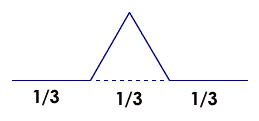
3. In this Koch curve, circle a piece that is the same shape as the whole
curve.
Many choices for solutions. Here are two:
4. The fractal rule for the Sierpinski triangle is to replace
each (point up) triangle with a new shape (shown below) which is formed by
connecting the midpoints of its sides, and erasing the middle, leaving 3 smaller
triangles:
triangle was |
Changed to: |
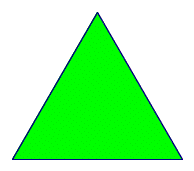 |
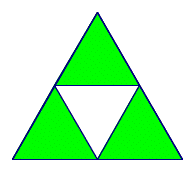 |
A. Draw the next iteration:
| iteration 0 |
 |
| iteration 1 |
 |
| iteration 2 |
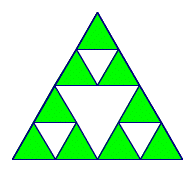 |
| new: iteration 3 |
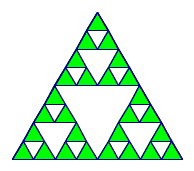 |
B. Complete the table below, and explain your rule for finding the numbers
that go in the table
| iteration number |
number of sements |
length of each segment |
total length |
| 0 |
3 |
1 m |
3 m |
| 1 |
9 |
1/2 m |
9/2 m |
| 2 |
27 |
1/4 m |
27/4 m |
| 3 |
81 |
1/8 m |
81/8 m |
| |
multiply previous number by 3 because you are getting 3 times as many
triangles every time OR each iteration is made of 3 smaller copies of the previous iteration |
divide by 2 (or x1/2 or x2 to the denominator) because the side length of a smaller triangle
is half as long as the larger triangle it came from |
|
C. Circle a piece that is the same shape (but smaller) as the whole
shape.
Many answers are possible. Two samples are shown.
